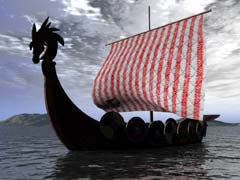
 If the details of the earliestNorse contact with Orkney are vague, the circumstances surrounding the founding of the Orkney earldom are no clearer.
If the details of the earliestNorse contact with Orkney are vague, the circumstances surrounding the founding of the Orkney earldom are no clearer.
Although the Orkneyinga Saga has no doubt regarding the events that led to the creation of the earldom, its version is historically dubious.
Written at least 300 years after the events it claims to portray, the saga account is highly suspect and very likely to be a literary creation.
It documents that Norway's first noteworthy dealings with Orkney involved the Norwegian King Harald Hárfagri (Fairhair), who set out to deal with renegade Vikings using the islands as a base for summer raids on Norway.
Heading 'west over sea', Harald's voyage of conquest saw him subduing Orkney, Shetland and the Hebrides, before sailing as far south as the Isle of Man.
The voyage of conquest
On this expedition, the son of the Norwegian Earl Rognvald of Møre was killed.
Rognvald was a powerful man who had aided in King Harald's efforts to unite Norway into one kingdom. So, to recompense the Earl for the loss of his son, King Harald gave Rognvald Orkney and Shetland.
But Earl Rognvald had no interest in the islands. He already had an earldom back in Norway, so passed Orkney and Shetland to his brother Sigurd - one of King Harald's warriors. Before Harald returned to Norway, Sigurd was confirmed as earl - theOrkneyinga Saga's first earl of Orkney.
But the saga account of Harald Fairhair's voyage is of doubtful historical accuracy. It is not corroborated in any other non-saga source and is probably just a piece of creative writing based on scraps of oral tradition and other Icelandic saga accounts of similar voyages - in particular that of King Magnus Barelegs.
It seems likely that Harald's voyage was an literary invention, based on an Icelandic historical tradition that King Harald was the reason for the exodus of Norwegians from their home country - an event the Icelanders saw as heralding the discovery and eventual colonisation of Iceland.
Harald may well have been responsible for some later emigrations from Norway, but there is no way he could have been the cause of the earlier movements to Orkney.
Harald only became King of a united Norway after the naval battle of Hafrsfjord.
This battle took place around 892AD - 100 years after the earliest Viking raids on Britain. His voyage to Orkney must therefore have taken place some time around this date, but the historical sources, such as the Irish Annals, make no mention of it.
An independent earldom?
Contact between Orkney and Norway had probably been ongoing for some time prior to King Harald's supposed westward expedition.
It is tempting to think of the Saga's Orkney based "Vikings" were perhaps political opponents of Harald, whose forceful subjugation of Norway had dispossessed a number of Norwegian landowners. Did they seek refuge with friends, families and allies who had already settled in the islands?
Another interesting hypothesis is that Earl Rognvald of Møre was actually the heir to an established independent power in Orkney. As such, Earl Sigurd the Mighty was not necessarily the first earl of Orkney - he was simply the first earl to make it into the surviving historical records.
Was Rognvald rewarded with lands in Møre and Romsdal after assisting Harald in his unification of Norway? And if so was Rognvald's claim to Orkney territories ratified by the King at the time? Hence the reference to Harald's conquest?
Earl Sigurd takes control
However the earldom began, by the time of Earl Sigurd we are heading into more reliable territory - although still laced with myth and folklore.
With Orkney in his hands, Sigurd had the means to expand his territory and, according to the saga, soon took Caithness, Sutherland and sections of Argyll on the Scottish mainland.
But it was on one such raid into Scottish lands that Sigurd the Mighty fell - suffering blood poisoning after AN encounter with the chieftain, Maelbrigte Tusk.
No comments:
Post a Comment